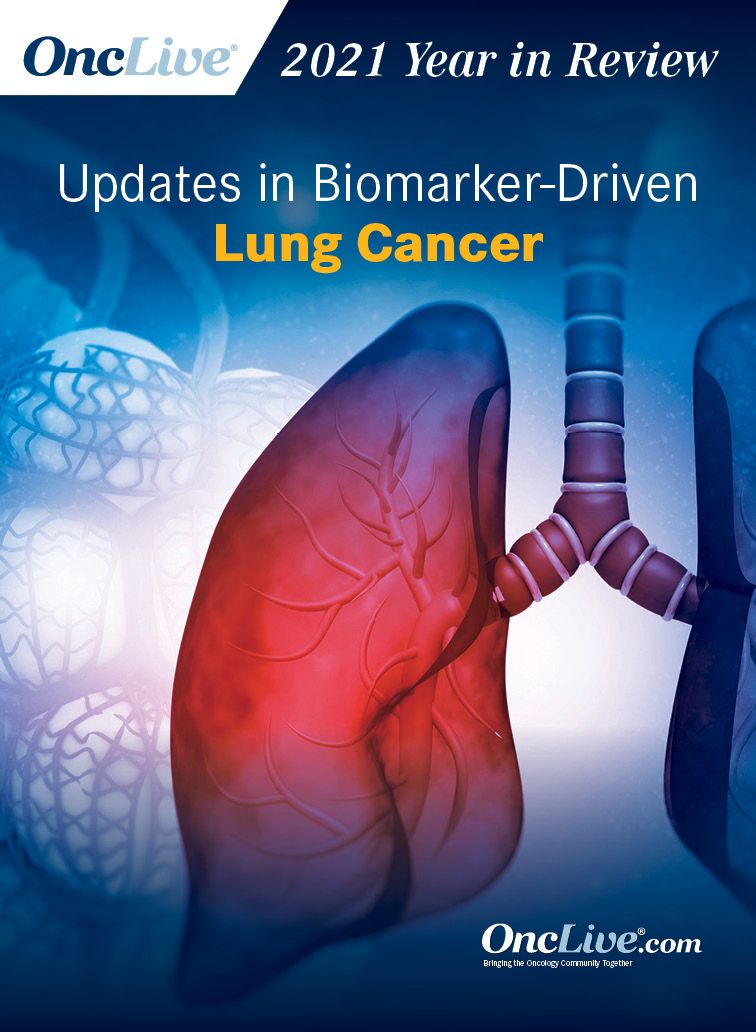Publication
Article
Supplements and Featured Publications
FDA Approvals Signify a Successful 2021 in Lung Cancer, But Resistance to Available Therapies Remains a Top Concern
Author(s):
The FDA approvals of several targeted therapies, such as sotorasib, amivantamab-vmjw, and mobocertinib, as well as immunotherapeutic strategies, such as adjuvant atezolizumab, represent significant advances made in 2021 for the treatment of patients with non–small cell lung cancer.
Roy S. Herbst, MD, PhD

The FDA approvals of several targeted therapies, such as sotorasib (Lumakras), amivantamab-vmjw (Rybrevant), and mobocertinib (Exkivity), as well as immunotherapeutic strategies, such as adjuvant atezolizumab (Tecentriq), represent significant advances made in 2021 for the treatment of patients with non–small cell lung cancer (NSCLC), said Roy S. Herbst, MD, PhD, who added that with these developments, targeting resistance to EGFR inhibitors will be a key research focus in 2022.
“In 2021, the [COVID-19] pandemic continued but lung cancer research improved,” said Herbst, the Ensign professor of medicine (medical oncology) and a professor of pharmacology at Yale School of Medicine, as well as the director of the Center for Thoracic Cancers and chief of Medical Oncology at Yale Cancer Center and Smilow Cancer Hospital. “We are moving in a direction to bring our best drugs, whether they be targeted therapy or immunotherapy, earlier. That stood out to me as a major accomplishment this year.”
During an interview with OncLive®,Herbst, who is also the associate cancer center director for Translational Science at Yale Cancer Center, highlighted some of the most significant developments made during 2021 in lung cancer and discussed where he believes research is headed in 2022.
OncLive®: What advances stand out regarding lung cancer management when you look back on 2021?
Herbst: 2021 was the year of adjuvant therapy. At the end of 2020, we had the approval of osimertinib [Tagrisso], which brought targeted therapy to the adjuvant setting [for patients with] EGFR-mutant, stage I, II, and III lung cancers.
Toward the end of 2021, we had the approval of adjuvant atezolizumab for [patients with] PD-L1–positive stage II and IIIa disease.
Also, [we saw] the approval of a host of new targeted therapies [directed against EGFR] exon 20 and RAS [mutations], for example.
How did some of the regulatory decisions change the scope of treatment for patients with lung cancer this year?
The fact that [sotorasib] was approved in the accelerated approval pathway was historic [because] we have been working to try to target KRAS for years. Now we finally have something [against KRAS G12C mutations], so that was major.
Of course, the approval of atezolizumab as adjuvant therapy, as well as the approvals of [amivantamab and mobocertinib] for patients with EGFR exon 20 insertions were great advances.
What trials evaluating targeted therapies will be important to keep an eye on in 2022?
As we move forward, from a targeted therapy point of view, the things to keep an eye on right now might be some of the trials for EGFR resistance with some of the newer drugs like amivantamab plus lazertinib [NCT04965090]. Some of the phase 3 studies will be important as they move forward.
Looking at ways to target osimertinib resistance will be important. We are also going to be looking at trials [attempting to overcome] resistance to immunotherapy.
Findings from the DESTINY-Lung01 trial (NCT03505710) demonstrated robust and durable antitumor activity with fam-trastuzumab deruxtecan-nxki (Enhertu) in patients with HER2-mutant NSCLC. What is next for this drug and targeting HER2 overall in lung cancer?
HER2 is not that [common] among patients [with NSCLC]; a small percentage of patients have HER2-mutated disease. However, many more have HER2 amplification. The fact that we can use an armed antibody-drug conjugate [ADC] is important.
There is also a HER3-directed ADC that is showing some activity in [patients with lung cancer who develop] EGFR resistance.
2021 was probably the year of the ADCs, as well, [directed toward] TROP2, HER2, and HER3. We will see more of that in the years to come.
What questions regarding immunotherapy were answered in 2021, and what do you anticipate the focus of immunotherapy research will be in 2022?
This year, there weren’t that many new studies, but we saw some consolidation and long-term data showing that there is a tail of the curve [with immunotherapy]. We learned that immunotherapy can probably cure patients with metastatic disease in the first-line or refractory settings. However, the other 70% to 80% of patients are not cured [with immunotherapy], so we need to figure out what we are going to do with those patients. What drugs can we use? How do we identify who needs combination therapy?
We didn’t have that much new [data] this year as far as what those combination [strategies] are. There were some hints from a trial called COAST [NCT03822351] that looked at patients post-chemoradiation with durvalumab [Imfinzi] compared with durvalumab plus a natural killer agonist or CD73 antagonist. [The data] showed some response rate and progression-free survival improvement. That was a signal-finding [study] to move [the field] forward. It was a positive result this year. However, the COAST trial was a phase 2 study, so we have a long way to go.
We also presented the 5-year data from the KEYNOTE-010 trial [NCT01905657], which certainly showed a nice tail of the curve [with pembrolizumab (Keytruda)].
We are developing a lot of signal-finding studies with immunotherapy. TIGIT is one that is high on the list, for example. Now, we need to figure out how to bring these [drugs] forward in a more accelerated way.
What areas of research would you like to see focused on in 2022?
I would like to see immune resistance targeted more. [For patients with] primary resistance who don’t respond to immunotherapy or chemoimmunotherapy, I want to understand why [they develop resistance] and give them different combinations. For patients with acquired resistance to immunotherapy, what do we do there? That is going to be important.










